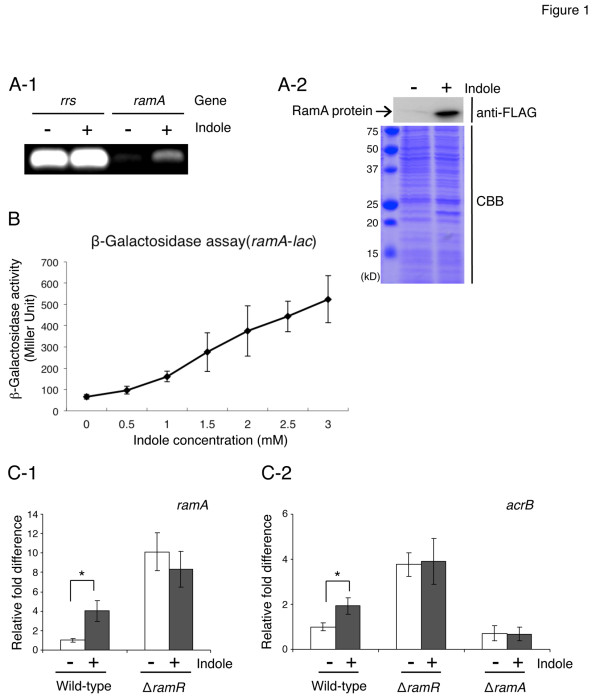Figure 1.
Indole induces efflux-mediated multidrug resistance genes. (A-1) RT-PCR measurement of indole effect on expression of ramA. Expression of rrs, encoding rRNA, was measured as a control. The wild-type strain ATCC14028s was grown in the presence (+) or absence (−) of 2 mM indole, and RT-PCR was performed after RNA isolation. (A-2) RamA production in the wild-type ATCC14028s derivative strain carrying the epitope-tagged ramA. NES114 (ramA-FLAG::KmR) was grown in the presence (+) or absence (−) of 2 mM indole. SDS-PAGE of lysates of NES114 was followed by Western blotting with an anti-FLAG antibody (anti-FLAG, top) or by staining with Coomassie brilliant blue (CBB, bottom). (B) β-Galactosidase levels in the wild-type ATCC 14028s derivative strain carrying the ramA-lac transcriptional fusion (NES84) treated with different indole concentrations. (C-1) qRT-PCR measurement of indole effect on expression of ramA. The wild-type strain (ATCC14028s) and its ramR::kanR deletion mutant were grown in the presence (+) or absence (−) of 1 mM indole. (C-2) qRT-PCR measurement of indole effect on expression of acrB. The wild-type strain ATCC14028s and its ramR::kanR and ramA::kanR deletion mutants were grown in the presence (+) or absence (−) of 1 mM indole. (B and C-1, 2) The data correspond to mean values from three independent replicates. The bars indicate the standard deviation. (C-1, 2) ramA and acrB expression levels were expressed relative to that measured in the wild-type strain grown without indole, which was assigned the unit value. Asterisks indicate statistically significant difference (p < 0.05) according to a two-tailed Student’s t-test.

